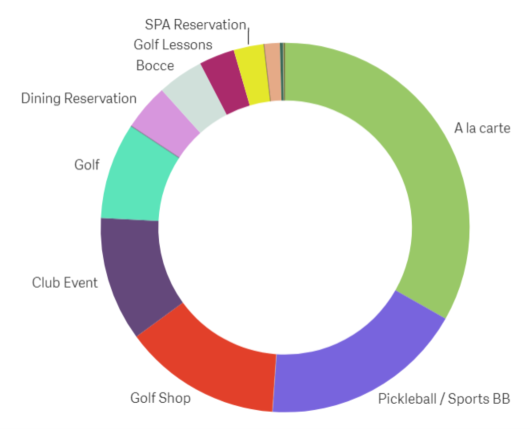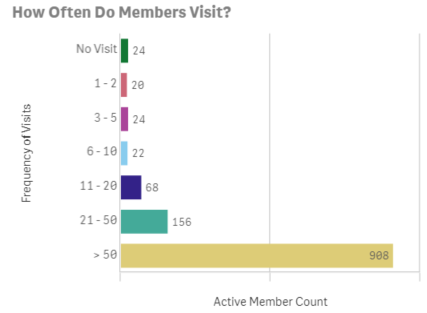The Story of Member Engagement

Member engagement is the lifeblood of private clubs. Without engaged members, private clubs don’t exist. Accurately measuring engagement can not only give management valuable insights into member usage patterns but also pinpoint members who are not using the clubs for further actions. Many clubs are not measuring engagement as much as they would like to due to three major challenges. First, the club needs to define, based on its culture and business goals, what consists of member engagements. Second, the club needs to decide what to measure, i.e., what types of reports and KPIs should the club produce, and what they can tell the club. Thirdly, the club needs to figure out how to assemble the data needed for the measurements.
What is member engagement?
Members interact with the club on many touch points. It could be dining, club events, playing golf, making a reservation, buying a t-shirt, etc. Clubs should decide which touchpoints are meaningful and important. For instance, touchpoints like security card swipes may not be important because they tell you very little about the member, others like golf playing or club events could be significant and therefore should be included in member engagement. The collection of interactions from important touchpoints consists of member engagement. The following pie chart is an example of member engagement in a typical club, each slice represents a touchpoint, and the size of each slice is how many interactions happen under the touchpoint.

Figure 1 – An example of a club’s member engagement summary. Each slice represents a touchpoint, and the size of the slice is how many interactions happen under the touchpoint
Getting The Data
Once the club defines what touchpoints should be part of member engagement, it’s time to gather the data needed for the analysis. According to a survey done by Golf Genius in 2019, an average club uses between 20 and 30 different systems to manage day-to-day operations. Most people rely on the reports that come with the systems to download the data. Clubs can tie data from these systems together using member numbers and date. There are commercial products like LC Consulting’s ClubPulse™ Dashboard that can automate data extractions for you. We will discuss these products in the last section.
What member engagement can tell you
After all the required data are extracted and integrated, clubs can start to analyze engagement data to understand how different members use the club and take actions based on the patterns learned. There could be so many ways to do this, here we only list three types of analysis that are common among clubs.
Analysis 1 – Segmenting Members Based on Their Interests
Members are very different from each other; this means the club should not market the same offers to everyone indistinctly. No member wants to receive offers they are not interested in. The image below shows two members’ engagement summaries. They have dissimilar interests and use the club in completely different ways. While both members are very active, Member A is a bigger spender, and she/he also enjoys playing golf a lot. Member B, on the other hand, plays a lot of tennis and spends a lot less on A la carte and golf shop items.

Figure 2 – Two members with very different interests
One way to improve targeting is to create member segmentation based on their interests. What can tell you more about member interests than their actual usage data? After these segments are created, marketing emails should be sent to members in segments that are most likely to be interested.
Analysis 2 – Identify members at risk
Member usage data can be viewed as a way for members to speak their minds. When a member barely comes to the club anymore, it could mean they might not be interested in renewing membership. Usually, the number one reason why members quit the club is because of low usage. The following graph count members by the frequency they visit the club, and it shows that 24 members never visited the club last year, and 20 members only came to the club once or twice.

Figure 3 – Member count based on the frequency they visit the club. The bars at the top are the count of members who barely come to the club
It is important for the club to find out why these members don’t use the club, especially if they are resident members living nearby, and take proper actions.
Analysis 3 – Seasonality
Member usage pattern changes dramatically at different times of the year. The following trending analysis of member engagement shows all the touchpoints, and how the number of interactions under each touchpoint varies as the year progresses. Understanding the trends can not only help clubs re-purpose some of the spaces when they are not used but also optimize staffing for non-peak seasons.

Figure 4 – Seasonal changes in member engagement.
Excel or Commercial Software
By now I hope it has become clear that measuring member engagement is extremely important. As we indicated before, it is all about extracting, merging, and analyzing data from various systems the club uses. Since member usage pattern changes all the time, it is recommended that each club should do this exercise at least once a quarter, if possible, to stay on top of the most recent trends. Clubs can either choose to do it themselves using Excel or buy commercial software like LC Consulting’s ClubPulse™ Dashboard. To help clubs make the best decision, the pros and cons of both approaches are listed below.
Excel
Pros
- No cost
- No need to learn new skills
Cons
- Can’t drill into details. It’s very difficult to load member-level transaction detail data into Excel
- Might be difficult to analyze engagement data by member demographics
- The entire process is manual and error-prone
Commercial Software
Pros
- Built-in best practices. The software vendor has learned the best ways to solve member engagement problems by working with many other clubs. There’s no need for the club to re-invent the wheel
- Easily drill into details. The software allows users to pin-point issues by quickly drilling into member-level transaction data
- Completely integrated with member demographics data
- Automated data refreshing
Cons
- Although the implementation and support costs of the software are affordable to most clubs, they are still more expensive than Excel
Conclusions
Data living in various club systems can be used to paint a picture of how members engage with the club. If done properly, analyzing member engagement can help the club to service members better as well as improve operational efficiency. The club can either use Excel or commercial software to extract, integrate, and analyze member engagement data and act on the results.
Leave a Reply